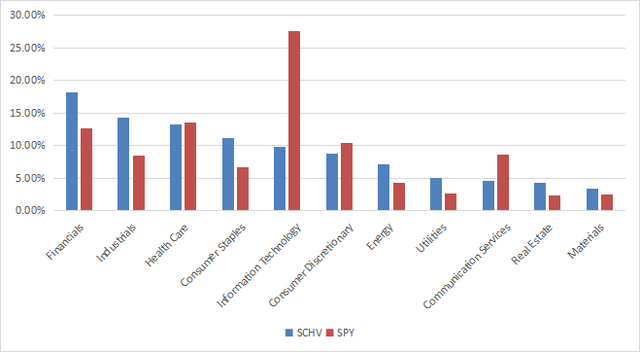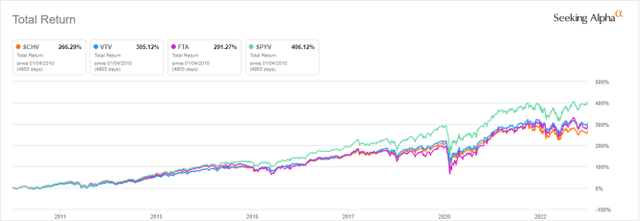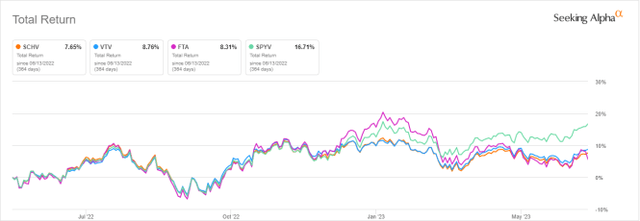This article series aims at evaluating ETFs (exchange-traded funds) regarding past performance and portfolio metrics. Reviews with updated data are posted when necessary.
SCHV strategy and portfolio
Schwab U.S. Large-Cap Value ETF™ (NYSEARCA:SCHV) started investing operations on 12/11/2009 and tracks the Dow Jones U.S. Large-Cap Value Total Stock Market Index. It has 519 holdings, a 12-month distribution yield of 2.47% and a very cheap expense ratio of 0.04%. Distributions are paid quarterly.
As described on S&P Dow Jones Indices website, the three main value factors used in the index constitution are the Projected Price-to-Earnings Ratio, the Price-to-Book Ratio and the dividend yield. It is weighted by float-adjusted market capitalization, rebalanced quarterly and reconstituted annually.
The fund has a low annual turnover: 6.7% for the most recent fiscal year. It invests almost exclusively in U.S. companies (98.7%), mostly in large and mega caps (about 70%), and to a lesser extent in mid-caps (about 29%). Despite the fund’s name, there are a few small cap constituents, but their weight is insignificant (less than 2%).
The fund is well-balanced across sectors: none of them weighs more than 20%. The heaviest one is financials (18.1%), followed by industrials (14.2%), healthcare (13.3%) and consumer staples (11.1). Other sectors are below 10%. Compared to the large cap benchmark SPDR® S&P 500 ETF Trust (SPY), SCHV massively underweights technology, communication and, to a lesser extent, consumer discretionary. It is almost on par in healthcare and moderately overweight in other sectors.
SCHV sector breakdown (chart: author, data: Schwab, SSGA)
As expected, SCHV is cheaper than the S&P 500 regarding valuation ratios, as reported in the next table.
|
SCHV |
SPY |
|
|
Price/Earnings TTM |
15.91 |
21.5 |
|
Price/Book |
2.4 |
3.75 |
|
Price/Sales |
1.66 |
2.39 |
|
Price/Cash Flow |
11.29 |
15.14 |
(data: Fidelity.)
The 10 holdings, listed below with valuation metrics, represent 18.5% of asset value. The heaviest position weighs about 3%, so risks related to individual companies are low. As a reference, the largest holding of SPY (Apple Inc.) is 7.5% of the fund’s value.
|
Ticker |
Name |
Weight |
P/E ttm |
P/E fwd |
P/Sales |
P/Book |
P/FCF |
Yield% |
|
BRK.B |
Berkshire Hathaway, Inc. |
3.12% |
96.17 |
21.59 |
2.30 |
1.44 |
31.69 |
0 |
|
XOM |
Exxon Mobil Corp. |
2.28% |
7.20 |
10.59 |
1.11 |
2.20 |
10.03 |
3.42 |
|
JNJ |
Johnson & Johnson |
2.16% |
33.44 |
15.02 |
4.33 |
5.88 |
95.34 |
2.98 |
|
JPM |
JPMorgan Chase & Co. |
2.13% |
10.40 |
9.67 |
2.33 |
1.52 |
9.36 |
2.84 |
|
PG |
Procter & Gamble Co. |
1.78% |
25.33 |
24.83 |
4.44 |
8.11 |
111.41 |
2.59 |
|
HD |
The Home Depot, Inc. |
1.56% |
18.33 |
20.06 |
1.96 |
841.91 |
58.89 |
2.78 |
|
CVX |
Chevron Corp. |
1.46% |
8.51 |
11.28 |
1.29 |
1.88 |
11.55 |
3.84 |
|
MRK |
Merck & Co., Inc. |
1.45% |
21.46 |
15.72 |
4.91 |
5.98 |
67.66 |
2.66 |
|
PEP |
PepsiCo, Inc. |
1.30% |
38.32 |
24.86 |
2.86 |
14.77 |
N/A |
2.78 |
|
ABBV |
AbbVie, Inc. |
1.26% |
32.43 |
12.51 |
4.31 |
18.43 |
18.33 |
4.30 |
Ratios: Portfolio123.
Portfolio quality
In previous articles, I have shown how three factors may help cut the risk in a portfolio: Return on Assets, Piotroski F-score, and Altman Z-score. In my ETF reviews, risky holdings are companies with at least 2 red flags among: bad Piotroski score, negative ROA, unsustainable payout ratio, bad or dubious Altman Z-score, excluding financials and real estate where these metrics are less reliable.
According to my calculation, 5.7% of SCHV holdings that are not in financials and real estate are risky regarding these assumptions (I did this calculation with the 237 holdings weighing more than 0.1%, which represent 86% of assets). My preferred aggregate quality metrics are very similar to the benchmark, as reported in the next table.
|
SCHV |
SPY |
|
|
Altman Z-score |
3.16 |
3.47 |
|
Piotroski F-score |
5.72 |
5.75 |
|
ROA % TTM |
7.49 |
7.4 |
Performance
Since 1/1/2010, SCHV has lagged the S&P 500 by 2.4 percentage points in annualized return. Risk metrics are similar (maximum drawdown and historical volatility in the next table).
|
Since 1/1/2010 |
Total Return |
Annual Return |
Drawdown |
Sharpe ratio |
Volatility |
|
SCHV |
270.22% |
10.22% |
-34.90% |
0.7 |
14.30% |
|
SPY |
392.30% |
12.59% |
-33.72% |
0.84 |
14.79% |
Data calculated with Portfolio123.
The next chart compares total returns since 1/1/2010 of SCHV and three of the most popular large cap value ETFs:
- Vanguard Value ETF (VTV)
- First Trust Large Cap Value AlphaDEX Fund (FTA)
- SPDR Portfolio S&P 500 Value ETF (SPYV).
SCHV has been lagging its peers.
SCHV vs. Competitors since 2010 (Seeking Alpha)
In the last 12 months, it is very close behind VTV and FTA, but it lags SPYV by a significant margin.
SCHV vs. Competitors, last 12 months (Seeking Alpha)
Comparing SCHV with my Dashboard List model
The Dashboard List is a list of 60 to 80 stocks in the S&P 1500 index, updated every month based on a simple quantitative methodology. All stocks in the Dashboard List are cheaper than their respective industry median in Price/Earnings, Price/Sales and Price/Free Cash Flow. An exception in utilities: the Price/Free Cash Flow is not taken into account to avoid some inconsistencies. Then, the 10 eligible companies with the highest Return on Equity in every sector are kept in the list. Some sectors are grouped together: energy with materials, communication with technology. Real estate is excluded because these valuation metrics don’t work well in this sector. I have been updating the Dashboard List every month on Seeking Alpha since December 2015, first in free-access articles, then in Quantitative Risk & Value.
The next table compares SCHV performance since 1/1/2010 with the Dashboard List model, with a tweak: here the Dashboard List is rebalanced quarterly to make it comparable with a passive index.
|
Since 1/1/2010 |
Total Return |
Annual Return |
Drawdown |
Sharpe ratio |
Volatility |
|
SCHV |
270.22% |
10.22% |
-34.90% |
0.7 |
14.30% |
|
Dashboard List |
433.63% |
13.26% |
-40.44% |
0.73 |
17.83% |
Past performance is not a guarantee of future returns. Data Source: Portfolio123.
The Dashboard List beats SCHV by 3% in annualized return. However, the fund’s performance is real and the list is simulated.
Two weaknesses of value indexes
I like the idea of mixing various ratios to rank value stocks. However, I think most value indexes doing so have two weaknesses, and SCHV is no exception. The first one is to classify all stocks on the same criteria. It means the valuation ratios are considered comparable across sectors. Obviously, they are not: my monthly dashboard here shows how valuation and quality metrics may vary across sectors.
The second weakness comes from the price/book ratio (P/B), which adds some risk in the strategy. Historical data show that a large group of companies with low P/B has a higher volatility and deeper drawdowns than a same-size group with low price/earnings, price/sales or price/free cash flow. The next table shows the return and risk metrics of the cheapest quarter of the S&P 500 (i.e. 125 stocks) measured in price/book, price/earnings, price/sales and price/free cash flow. The sets are reconstituted annually between 1/1/2000 and 1/1/2023 with elements in equal weight.
|
Annual Return |
Drawdown |
Sharpe ratio |
Volatility |
|
|
Cheapest quarter in P/B |
8.54% |
-81.55% |
0.35 |
37.06% |
|
Cheapest quarter in P/E |
10.71% |
-73.62% |
0.48 |
25.01% |
|
Cheapest quarter in P/S |
12.82% |
-76.16% |
0.47 |
34.83% |
|
Cheapest quarter in P/FCF |
15.32% |
-74.77% |
0.61 |
27.03% |
Data calculated with Portfolio123.
This explains why I use P/FCF and not P/B in the Dashboard List model.
Takeaway
Schwab U.S. Large-Cap Value ETF holds about 500 stocks with value characteristics based on three metrics: forward P/E, price/book and dividend yield. It is better diversified than SPY across sectors and holdings, and it is cheaper regarding management fee and valuation ratios. Quality metrics are similar. SCHV has underperformed the benchmark and three major competitors, but price history mostly covers a growth-oriented market. It may do better in a period more favorable to value investing style.
Schwab U.S. Large-Cap Value ETF may also be useful in a tactical allocation strategy switching between growth and value styles. Independently of the growth/value paradigm, I see two weaknesses in the underlying index: ranking stocks regardless of their industries, and relying too much on the price/book ratio.
Read the full article here


